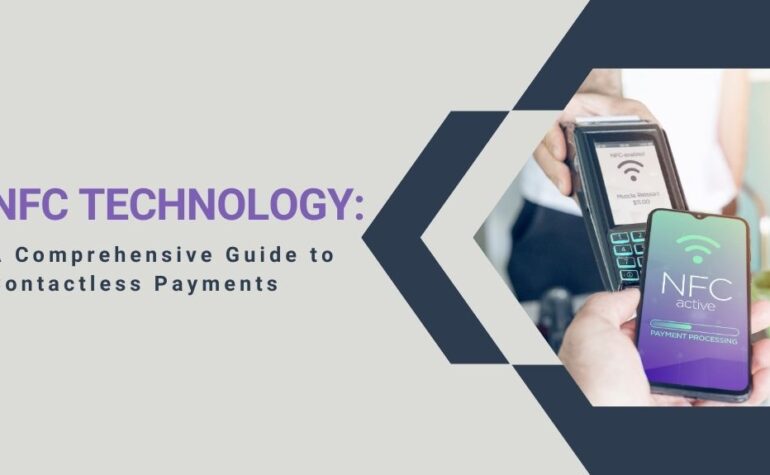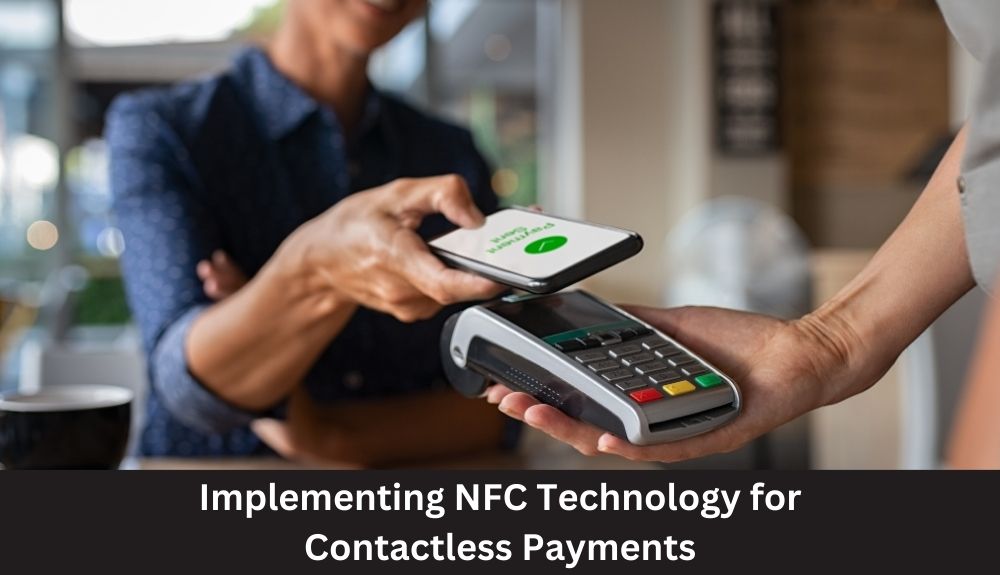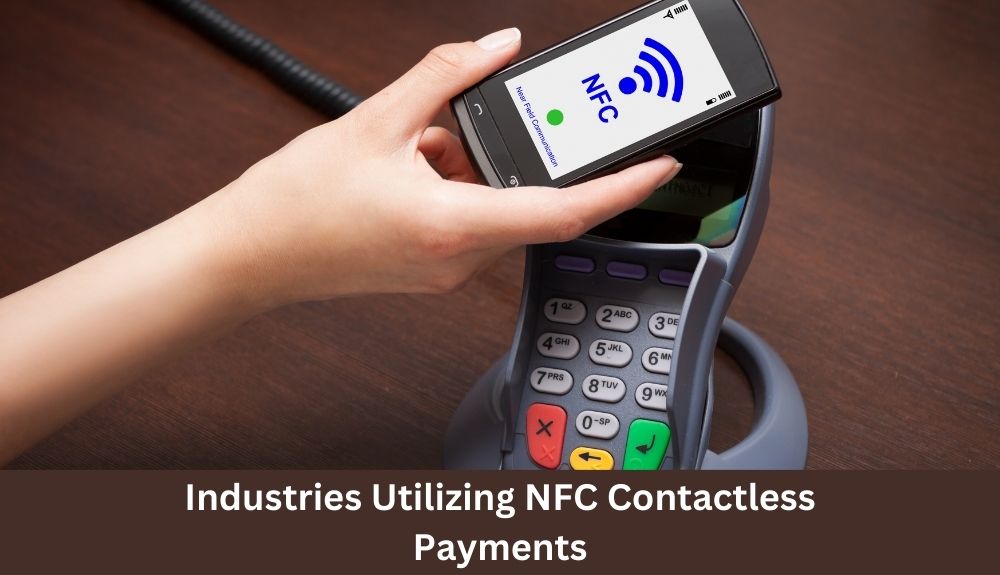Best Credit Card Processing Solutions Tailored for Every Industry

By merchantservices March 29, 2024
Are you tired of fumbling for cash or swiping your card for every transaction? Imagine a world where a simple tap is all it takes to make a payment – welcome to the realm of NFC (Near Field Communication) technology. Revolutionizing the way we pay, NFC enables seamless and secure contactless transactions, offering a convenient and efficient way to handle your financial transactions on the go.
In this comprehensive guide to contactless payments, we delve into the intricacies of NFC technology, shedding light on its role in facilitating secure and swift transactions. From understanding the basics of how NFC works to exploring the benefits it brings to businesses and consumers alike, this blog unravels the mysteries behind this innovative payment method.
Join us on a journey to uncover the technological workings behind NFC, its impact on the payment landscape, and the advantages it offers in enhancing the shopping experience. Get ready to demystify the world of contactless payments and embrace the future of seamless transactions with NFC technology.
Introduction to NFC Technology and Contactless Payments
Near Field Communication (NFC) technology is revolutionizing the way we make payments, offering a convenient and secure solution for businesses and consumers alike. By enabling contactless payments, NFC allows users to simply tap their smartphones or other NFC-enabled devices on payment terminals to complete transactions seamlessly.
The benefits of contactless payments are significant. For businesses, NFC technology streamlines the checkout process, reducing transaction times and increasing customer satisfaction. It also expands payment options, accommodating customers who prefer using mobile wallets or contactless cards. Additionally, adopting NFC technology can enhance a business’s reputation for embracing innovation and providing superior customer experiences.
Consumers also enjoy various advantages when using contactless payments through NFC. It offers unparalleled convenience, allowing users to make quick and hassle-free transactions. There’s no need to fumble for cash or cards, and NFC transactions are typically faster than traditional payment methods. Furthermore, NFC technology incorporates robust security features, providing peace of mind for both businesses and consumers.
As contactless payments continue to gain popularity, understanding how NFC technology works and its benefits becomes paramount for businesses aiming to thrive in today’s digital economy. In the following sections, we will delve deeper into the principles behind NFC mobile payments, implementation strategies, safety considerations, advantages and disadvantages, and explore industries successfully leveraging NFC contactless payments. Let’s dive in and uncover the immense potential of NFC technology in facilitating seamless and secure transactions.
Understanding How NFC Mobile Payments Work
NFC mobile payments have revolutionized the way we make transactions, offering a seamless and convenient payment method for businesses and consumers. Understanding the principles behind NFC mobile payments is key to harnessing the full potential of this technology.
The Communication Process
At its core, NFC (Near Field Communication) works by establishing a wireless connection between two devices in close proximity. Typically, one device acts as the “reader” or “initiator,” such as a smartphone or payment terminal, while the other device is the “tag” or “receiver,” like a contactless payment card or another smartphone.
When a customer initiates an NFC payment, the payment terminal or smartphone reader generates a radio frequency field. The contactless payment card or another smartphone with an NFC-enabled mobile wallet then responds to the field and establishes a connection. This communication allows the secure transmission of payment information between the two devices.
Security Features
NFC mobile payments prioritize security to ensure safe and reliable transactions. One of the key security features is the use of tokenization. Instead of transmitting the actual credit card number or personal information, NFC mobile payments generate a unique, randomly generated one-time-use code, or token, for each transaction. This code is then securely transmitted between devices, safeguarding the customer’s sensitive data.
In addition to tokenization, NFC mobile payments also utilize encryption and secure element technology. Encryption ensures that the data transmitted between devices is encoded and cannot be intercepted or tampered with. Secure element technology, often embedded in NFC-enabled smartphones or contactless payment cards, provides an additional layer of protection by securely storing and processing payment information.
As a result of these security features, NFC mobile payments offer a more secure and protected payment option compared to traditional magnetic-stripe cards.
By understanding the communication process and security features of NFC mobile payments, businesses can implement this technology confidently, ensuring a smooth and secure payment experience for their customers.
Remember, it’s important to make sure that your payment terminal or smartphone reader supports NFC technology. This enables you to accept NFC mobile payments and provide your customers with a fast and convenient way to pay.
Implementing NFC Technology for Contactless Payments

Implementing NFC technology for contactless payments requires careful planning and consideration. Here are the key steps businesses need to take to successfully incorporate NFC into their payment systems:
Step 1: Assess Business Needs and Objectives
Before diving into implementation, businesses should identify their specific needs and objectives. This includes determining how contactless payments can benefit their operations, such as faster transaction times and improved customer experience. By understanding their goals, businesses can tailor their NFC implementation strategy accordingly.
Step 2: Choose NFC-Enabled Hardware and Software
To enable contactless payments, businesses need NFC-enabled hardware and software. This includes NFC-capable payment terminals, point-of-sale (POS) devices, and mobile devices such as smartphones or tablets. It’s important to choose reliable, secure, and compatible hardware and software solutions that integrate seamlessly with existing systems.
Step 3: Ensure Network Connectivity
NFC transactions require a stable and secure network connection. Businesses should ensure that their payment infrastructure supports reliable connectivity, whether through Wi-Fi, Ethernet, or cellular networks. Adequate network bandwidth is crucial to handle transaction volumes effectively.
Step 4: Integrate NFC into POS Systems
Integrating NFC functionality into existing POS systems is a critical step. This involves working closely with payment processors or acquiring banks to enable NFC capabilities. Businesses may need to update software, install NFC drivers, or make configuration changes to ensure seamless communication between NFC-enabled devices and the POS system.
Step 5: Implement Robust Security Measures
Security is paramount when implementing NFC technology for contactless payments. Businesses must adhere to industry standards and best practices to protect sensitive customer information. This includes encryption protocols, tokenization, and secure key management to safeguard transaction data.
Step 6: Employee Training and Customer Education
Once NFC technology is implemented, it’s crucial to provide comprehensive training for employees. Staff members should be familiar with the NFC payment process, troubleshooting common issues, and ensuring a seamless customer experience. Additionally, businesses should provide clear and concise educational materials to help customers understand the benefits and security of NFC contactless payments.
By following these steps, businesses can successfully implement NFC technology for contactless payments. It’s important to work closely with experts in the field and stay updated on the latest advancements in NFC technology to optimize the payment experience for both businesses and consumers.
Safety and Security Considerations for NFC Contactless Payments
In an era of rapidly advancing technology, safety and security are paramount concerns when it comes to contactless payments using NFC technology. Both businesses and consumers alike want the reassurance that their transactions are secure and protected from potential threats. Fortunately, NFC contactless payments have several security measures in place to ensure a safe and seamless payment experience.
Encryption and Authentication
One of the key security features of NFC technology is encryption. When making a contactless payment, the transaction data is encrypted, preventing unauthorized access or interception. This ensures that sensitive information, such as credit card numbers or personal identification details, remain safeguarded throughout the transaction process.
NFC contactless payments also rely on authentication mechanisms to verify the legitimacy of devices involved in the transaction. This involves a series of checks that confirm the authenticity of both the customer’s mobile device and the payment terminal. By verifying the identity of the participating devices, the risk of fraudulent transactions is minimized.
Tokenization
Tokenization is another security measure employed in NFC contactless payments. Instead of transmitting actual card information, a unique token is generated for each transaction. This token acts as a placeholder for the cardholder’s data, eliminating the need to transmit sensitive information during the transaction process. This adds an extra layer of protection, as even if intercepted, the token holds no value to potential attackers.
Fraud Monitoring and Liability Protection
Financial institutions and payment service providers implement advanced fraud monitoring systems to detect and prevent fraudulent activity. These systems analyze transaction patterns, flagging any suspicious behavior or potential security breaches. In case of unauthorized transactions, liability protection offers consumers recourse, providing peace of mind in the event of fraudulent use.
Consumer Education and Awareness
To further enhance security, education and awareness play a crucial role. Consumers should be informed about safe practices when using NFC contactless payments, such as regularly updating their mobile devices with the latest security patches and avoiding suspicious or untrusted payment terminals. By being aware of potential risks and taking precautionary measures, consumers can actively protect themselves from fraudulent activities.
In conclusion, NFC technology for contactless payments incorporates robust safety and security measures to protect both businesses and consumers. Encryption, authentication, tokenization, fraud monitoring, and consumer awareness collectively contribute to a secure and trustworthy payment environment. With these security considerations in place, NFC contactless payments offer a convenient and secure payment method for businesses and consumers alike.
Advantages and Disadvantages of Accepting NFC Mobile Payments
As businesses navigate the ever-evolving landscape of payment technology, NFC mobile payments have emerged as a compelling option. Let’s explore the advantages and disadvantages of accepting NFC mobile payments, considering both the benefits and potential challenges.
Benefits of Accepting NFC Mobile Payments
1. Increased Transaction Speed: NFC mobile payments offer a swift and seamless payment experience. Customers can simply tap their NFC-enabled devices on the payment terminal, reducing transaction times and enhancing efficiency.
2. Convenience for Customers: With the rise of mobile wallet apps like Apple Pay and Android Pay, customers appreciate the convenience of having their payment information stored securely on their smartphones. NFC technology enables a contactless payment process, eliminating the need for physical cards or cash.
3. Enhanced Security: NFC utilizes encryption and authentication protocols that provide a secure environment for transactions. Each transaction generates a unique code, making it difficult for fraudsters to replicate or intercept sensitive payment information.
4. Future-Proof Technology: As NFC-enabled smartphones become more prevalent, accepting NFC mobile payments ensures compatibility with the latest payment methods. By embracing this technology, businesses position themselves for continued growth and evolution in the digital payment landscape.
Drawbacks of Accepting NFC Mobile Payments
1. Hardware and Infrastructure Investment: Implementing NFC payment capabilities may require businesses to upgrade their payment terminals to support NFC transactions. This initial investment can be a deterrent for some businesses, particularly smaller merchants with limited resources.
2. Compatibility Issues: While NFC mobile payments are gaining traction, not all devices or payment terminals are NFC-enabled. This can create challenges for businesses and customers, leading to potential frustration and inconvenience during the payment process.
3. Limited Transaction Amounts: Some NFC mobile payment methods impose transaction limits, which may restrict higher-value purchases. Businesses need to communicate these limits effectively to customers to manage expectations and avoid any potential dissatisfaction.
4. Education and Adoption: Accepting NFC mobile payments requires educating both employees and customers about the technology and how to utilize it effectively. This educational effort can require time and resources upfront, but it is crucial for a seamless adoption process.
In conclusion, accepting NFC mobile payments offers numerous benefits such as increased transaction speed, convenience, enhanced security, and future-proofing. However, businesses should also consider the potential challenges of hardware investment, compatibility issues, transaction limits, and the need for education and adoption. By carefully weighing the advantages and disadvantages, businesses can make informed decisions about integrating NFC mobile payments into their operations and provide an enhanced payment experience for their customers.
Industries Utilizing NFC Contactless Payments

NFC contactless payments have gained significant traction across a wide range of industries. As businesses strive to offer seamless and convenient payment options to their customers, they are implementing NFC technology to enhance the overall customer experience. Here are some of the industries that have successfully embraced NFC contactless payments:
1. Retail and E-commerce
In the retail sector, NFC contactless payments have become increasingly popular. Many leading retailers now accept NFC mobile payments, allowing customers to make purchases quickly and securely using their smartphones or smartwatches. This technology eliminates the need for physical cards or cash, making transactions more convenient for shoppers.
2. Hospitality and Entertainment
Within the hospitality and entertainment industries, NFC contactless payments provide streamlined payment solutions for events, ticketing, and concessions. From music festivals to sports arenas, NFC-enabled wristbands or tickets allow attendees to effortlessly make purchases without the hassle of carrying physical cash or cards.
3. Transportation and Travel
NFC technology has significantly transformed the transportation and travel sectors. Public transportation systems in various cities have adopted NFC contactless payments, enabling commuters to conveniently tap their smartphones or contactless cards to pay for fares. Additionally, hotels and airlines provide NFC-enabled payment options, enhancing the travel experience for their customers.
4. Food and Beverage
Restaurants, cafes, and fast-food chains have also incorporated NFC contactless payments to expedite transactions. Customers can simply tap their mobile devices or contactless cards at payment terminals, eliminating the need for physical menus or cash transactions. This technology promotes efficiency and enhances the overall dining experience.
5. Healthcare
The healthcare industry has recognized the value of NFC contactless payments for patient billing and insurance purposes. Medical facilities can securely process payments using NFC-enabled devices, ensuring a seamless and efficient payment experience for both patients and healthcare providers.
6. Events and Conferences
NFC-enabled badges and wristbands have revolutionized the events and conference industry. Attendees can seamlessly make purchases within the event premises, ensuring a hassle-free experience. This technology also facilitates easy access to personalized event information and networking opportunities.
These are just a few examples of industries utilizing NFC contactless payments. As this technology continues to evolve and gain broader acceptance, more sectors are likely to adopt NFC technology to enhance their payment systems and cater to the growing demand for fast and secure transactions.
Conclusion and Future Outlook
In conclusion, NFC technology has revolutionized the way we make payments by enabling contactless transactions. Throughout this guide, we have explored the various aspects of NFC and its role in facilitating contactless payments for businesses and consumers.
By utilizing NFC mobile payments, businesses can offer a seamless and convenient payment experience to their customers. With just a simple tap, transactions can be processed quickly, reducing waiting times and enhancing customer satisfaction. The ability to accept NFC mobile payments also opens up new opportunities for businesses to attract tech-savvy customers and stay ahead of the competition.
Looking ahead, the future of NFC technology in the payment industry is promising. With the increasing adoption of NFC-enabled devices and mobile wallets, we can expect to see even more widespread acceptance of contactless payments. This technology has the potential to simplify and streamline transactions across various industries, from retail and hospitality to transportation and healthcare.
As NFC technology continues to evolve, we can anticipate enhanced security features to further protect the integrity of contactless payments. This includes advancements in encryption protocols and authentication methods, ensuring that transactions are secure and protected against unauthorized access.
Overall, NFC technology offers exciting possibilities for businesses and consumers alike. By embracing this innovative payment solution, businesses can tap into the growing trend of contactless payments and provide seamless experiences for their customers. As the payment landscape evolves, staying informed and adaptable to new technologies like NFC will be crucial for businesses to remain competitive and meet the changing needs of their customers.
